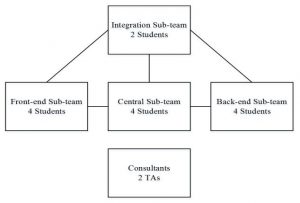15 Effect of Different Instructor(s) on CAMPing
Dr. Samy El-Tawab and Dr. Emil Salib
Rationale: This proposal presents a new methodology of curriculum for teaching as a possible practical teaching method. Rapid advances in technology require instructors to propose university-level classes that allow students to be educated, be technically skillful, and socially aware and ready for the job market. As a result, many instructors become overwhelmed by the vast range of group projects their students complete. There is no reliable method to determine which approach is most efficient and most likely to contribute to the growth and development of all learners. Computer Networking and Technology undergraduate programs seek to identify the most effective strategies, and determine the best teaching methods for students, based on an all-class project method and identified project needs. Before implementing new teaching methodologies, professors often experiment during the semester to evaluate the issues, challenges, and benefits within a specific approach. The purpose of this quantitative research study was to introduce a new methodology of curriculum for teaching an All-Class Method Project based Undergraduate Course (CAMPing) as a possible practical teaching method that could be repeated if a different instructor followed the same process and curriculum method. ”Can CAMPing be a repeatable practical teaching method if a different instructor followed the same theme process and curriculum method?” research question served as the framework for the argument that explicit practical teaching activities at the undergraduate levels of computer, technology, and networking studies could be effective. We have adopted CAMPing in the last four years with great success. We would like to conduct surveys to assess the effectiveness and the reproducibility of the CAMPing method. In addition, we clarified how the CAMPing method evolved from the original practice, research and application of the EVC (Expectancy-Value-Cost) model. We believe that this method has a significantly high value in preparing undergraduate students to succeed in the demanding and practical environment of the workplace.
Plan for design and implementation: CAMPing is a 300-level class usually offered during the spring semester as one of the courses needed to satisfy the requirements of the Bachelor of Science degree. CAMPing is a student-centered active-learning environment which provides hands-on experiences and learning opportunities to mix junior and senior level students. In this class, an advisor presents a unique experience and approach to students who have a diverse background and interest in science, technology, and engineering. The students are challenged to define, design, implement, deliver, and assess an end-to-end solution in a semester-long, hands-on, project-based course. This one-semester course is designed to foster a highly motivating learning environment. This study was conducted under the following set of assumptions:
•Course required: ISAT/TNS Sector
•Size of the class (each section): Up to 14 students
•Student diversity: Students are from different majors (e.g., Computer Science (CS), ComputerInformation System (CIS), and ISAT (with concentration in TNS, and IKM).
•Duration of the course: one semester (15 working weeks)
•Frequency and duration of class meetings: once a week for 100 minutes
•Role of course professor: coach and customer advocate; assessment and feedback provider; and, advisor
•Facilities: 24×7 accessible Instrumentation and Measurement Lab, a Computer Networking and Security Lab
•Resources: official advisor (one faculty: ); teaching assistants (two TAs); unofficial advisor (one senior faculty: Dr. XXXXX); lab support (one electronics technician: XXXX)
•Expected deliverables: one working prototype of the end-to-end solution, project report, and presentation
•Weekly individual grade is given based on their weekly performance
CAMPing design demonstrates that an end-to-end solution can be implemented by dividing a large team into sub-teams similar to a network-based, application architecture model, which includes a front-end user experience computing component, a central networking computing component, a back-end physical computing component, and integration as shown in Figure 2. The front-end, user experience computing component represents user experience and associated user interfaces, through which a user may enter, submit, or retrieve data. The central component communicates between the front-end and back-end of the sub-team for the purpose of submitting, storing, and retrieving data over a variety of different physical and logical networking channels and protocols. The back-end component of the solution represents the data collection, monitoring, and/or controlling functions. Integration sub-team members are responsible for integration of information to the end-to-end integrated solution. It is critical to highlight the importance of having one senior in the integration team. Also, the Teaching Assistants (TAs) must be two senior students who have done great in this class previously.

Figure 2.ISAT 306 Organizational Chart
Outcome of the innovative and creative teaching: We would like to “Evaluate our methodology”, The semi structural questions are designed to determine whether CAMPing can be repeatable practical teaching method if a different instructor followed the same theme process and curriculum method or not. Indeed, measuring faculty motivation and performance is important, however the most important part is how much the instructor(s) is willing to repeat themselves every year over and over again.
Plan for result dissemination: we plan to submit our finding in one of the educational technology conferences in the AACE: Association for the Advancement of Computing in Education: http://www.aace.org/ and one regional conference such as the TLT: The Teaching and Learning with Technology Conference at James Madison University (usually in October of each year).

